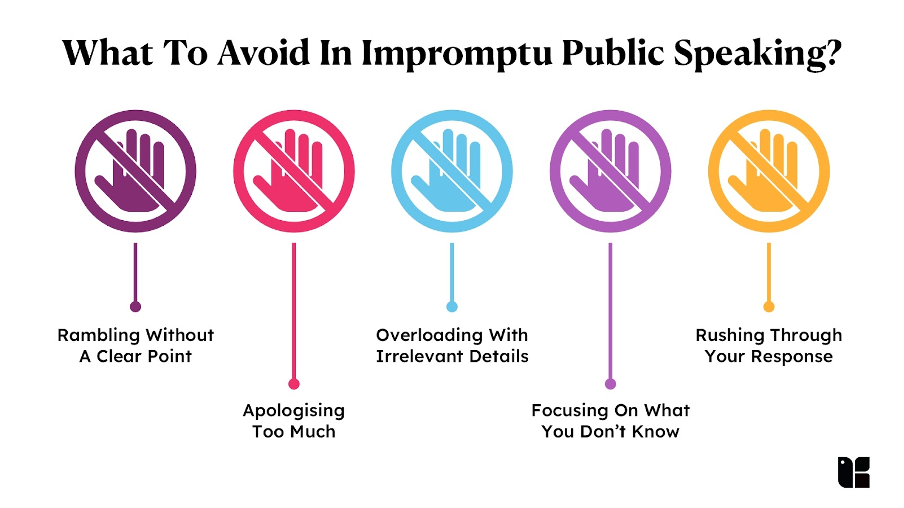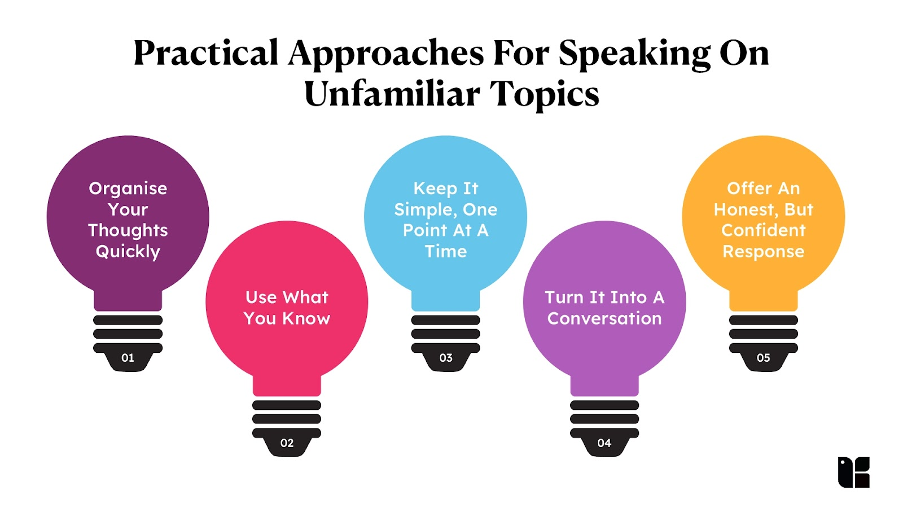Public speaking can be challenging on its own, but being asked to talk about a topic you’ve just heard about takes the pressure to a whole new level. You might believe that knowing enough or being fully prepared is the only way to speak confidently. But what happens when there’s no time to prepare, and you’re suddenly put in the spotlight?
Speaking confidently on unfamiliar topics isn’t about having all the answers, it’s a skill. With the right techniques, you can stay composed, organise your thoughts quickly, and deliver with impact.
First, let’s understand the common mistakes we make when put on the spot, because recognising and avoiding them is the first step toward speaking with confidence.
What To Avoid In Impromptu Public Speaking?
Certain patterns of behavior can make things even more challenging. Let’s break down these mistakes, why they happen, and how they affect your delivery.
Rambling Without A Clear Point
When you don’t know much about a topic, your mind tries to fill the gaps, and that often leads to rambling. You might start talking in circles, hoping something sticks. This happens because your focus shifts to “saying more” rather than “saying something meaningful.” Unfortunately, this not only confuses your audience but also makes you come across as unprepared.
Apologising Too Much
Many people instinctively apologise when they’re unsure, saying things like, “I’m sorry, I’m not an expert on this,” or “This might not be right.” While it comes from a place of honesty, it can make you seem less confident and discredit the valid points you’re making.
Overloading With Irrelevant Details
When you’re unprepared, it’s tempting to get into small, unrelated details to fill the silence. This usually happens because your brain is scrambling to sound credible, and it defaults to over-explaining. But instead of impressing your audience, it can overwhelm them or make your response seem scattered.
Focusing On What You Don’t Know
When we’re asked to speak on an unfamiliar topic, our minds often fixate on what we don’t know. This self-doubt can quickly take over, making you sound hesitant or unprepared. It might lead to filler words, unnecessary pauses, or overthinking every sentence.
Rushing Through Your Response
When caught off guard, the fear of silence or “messing up” can make you speak too quickly. While this feels like you’re getting it over with, it can leave your audience struggling to keep up or absorb your message.
By recognising these mistakes, you’re already on the path to avoiding them and responding with clarity and confidence. Let’s move on to some practical techniques to prepare for these situations.
Practical Approaches For Speaking On Unfamiliar Topics
While you might not have all the time in the world to prepare, these methods help you structure your response clearly and confidently on the spot.

Organise Your Thoughts Quickly
Before jumping into your response, give yourself a brief moment. Once you’ve taken a moment to breathe, the next step is organising your thoughts quickly. A solid way to do this is using the PREP method:
- Point: What is the main idea you want to communicate? Identify your key message.
- Reason: Why is this important? State the significance of your point.
- Example: Offer a brief example to support your message—this can be a personal experience or a relatable situation.
- Point: Reinforce your key message to wrap up.
This method helps you create a simple structure that keeps your response clear and focused. Instead of rambling, you’ll know exactly how to break your response into digestible parts, making your speech flow naturally.
Use What You Know
Even if the topic is unfamiliar, it’s likely that you can draw connections between what you already know and the new subject. For example, if you’re asked about a specific tech trend but aren’t familiar with it, relate it to broader technology trends you are comfortable with. Think of it this way: “While I don’t know the specifics about this new tool, it’s similar to the way we saw earlier trends like X develop.”
This approach shows your audience that you are knowledgeable and can connect ideas, even if the specific details are unfamiliar. The key here is to frame your response using familiar concepts—this keeps you confident and adds credibility.
Keep It Simple, One Point At A Time
It’s tempting to start throwing out a lot of information when you’re uncertain, but simplicity is key. Stick to one or two main points, and focus on explaining them well. Don’t overcomplicate things, give a clear message with examples or insights that make it easy for your audience to follow. For instance, if the topic is about leadership during a crisis, you might only need to focus on one aspect of leadership, like decision-making under pressure, and elaborate on that with a relatable example.
Turn It Into A Conversation
If you’re really stuck, turn the speaking opportunity into a more interactive moment by engaging the audience. You don’t have to have all the answers; you can ask for their thoughts or input. For instance, you could say, “I’m not fully up to speed on this, but I’m curious, how have you all seen this in action?” This helps you gather valuable insights while giving you a moment to regroup.
Not only does this approach buy you some time, but it also shifts the focus away from you and onto a shared conversation, which makes the whole experience less daunting.
Offer An Honest, But Confident Response
If you’re completely unfamiliar with the topic, don’t be afraid to acknowledge that, but do so in a confident manner. You might say something like, “I’m not an expert in this area, but here’s what I do know…” This way, you’re honest without apologising. You’re acknowledging the gap in your knowledge without discrediting your ability to contribute.
Make sure to follow up with whatever insights you can offer. People appreciate honesty, and framing it confidently helps maintain your authority as a speaker.
Conclusion
How you deliver your message is just as important as what you say. To maintain confidence, slow down and speak clearly, allowing your audience to follow your points easily. Use positive body language, stand tall, make eye contact, and use gestures to emphasise key points. By reframing the situation with a positive mindset, you’ll feel more confident and composed, ready to handle any topic that comes your way.












Comentar